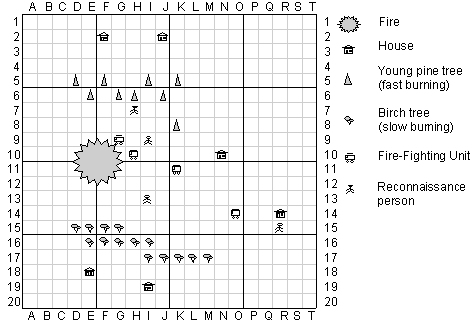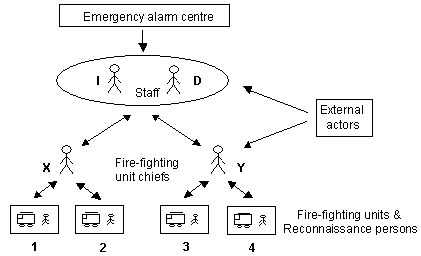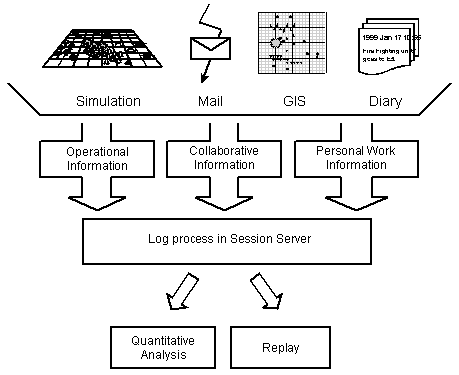C3Fire Features
Simulation environment
The C3Fire system generates a task environment in which a group of people co-operate to obtain an overview over the situation in order to extinguish a forest fire. An example of an organisation is viewed in figure 2 below. The tasks for the staff members in this setting are to co-ordinate and schedule the fire-fighting units so that they jointly can extinguish the fire, save houses (communities) and other areas with value. Communication among the participants is possible with different means, which are dependent on the configurations and conditions that are chosen for each session respectively. The simulation includes forest fire, houses, different kinds of vegetation, computer-simulated agents as fire-fighting units. Read more >>
Session control
|
To create a proper training or research session the organisation and the task environment for the subject can be controlled by a session configuration and by time stamped event in a scenario definition. |
|
Organisation Configuration |
The user interfaces and communication tools can be individual set-up for all participants in a session. When collaboration is mediated via computer systems, the system design impacts on the collaborative process. This means that the session controller may have explicit control over some aspects of collaboration. |
|
Simulation Configuration |
With the simulation configuration the session designer can define the properties of the geographical environment, the characteristics of the target system (the fire) and the properties of the simulated resources that the trained organisation can use to solve their task. |
|
Scenario |
With the scenario definition the session designer can define the dynamic characteristics of the session settings. It consists of events that will effect the session at some specified time. |
Monitoring
|
To be able to analyse the collaborative work in the C3Fire system, monitoring is integrated in all modules of the system. During a session the C3Fire system creates a log with all events in the simulation and all computer- mediated activities performed by the students. Figure 3 shows a view of the log process. The log process receives information from the simulation about the current activities in the simulated world. It also receives information about individual work in terms of marks in the personal GIS (map system), and on the collaborative work in terms of information about the e-mail communication and the use of the distributed GIS and diary. When the log information is centralised to the session server, where it is used in two ways: quantitative analysis and session replay. Read more >> |
Modules
When the training or research goals demand an increased level of complexity, one or more modules can be added to C3Fire. Read more >>
Example on complexity increase modules are :
|
Water Logistic |
The water logistic module add complexity to the traditional fire-fighting unit. It adds a new unit to the setting and also a new object.
The fire-fighting unit gain ability to be equipped with a water tank. The tank have a size and the amount of water decrease when the unit is fighting fire.
The new unit have a water tank and ability to fill the fire-fighting units water tank.
The new geographical object transfer water to a unit. The object can be represented by an image of a station or a lake etc. |
|
Fuel Logistic |
The fuel logistic module add complexity to the traditional fire-fighting unit. It adds a new unit to the setting and also a new object.
The fire-fighting unit can be equipped with a fuel tank. The tank have a size and a fuel level. The amount of fuel decrease when the unit is moving.
The new unit have a fuel tank and ability to fill the fire-fighting units fuel tank.
The new geographical object transfer fuel to a unit. The object can be represented by an image of a filling station |
Microworld / Scaled World
|
C3Fire can be configured so that it appears as a microworld or scaled world. A microworld means that the system designers has select the important characteristics of the real system and create a small and well-controlled simulation system with these characteristics. The advantage of using a microworld is that the complex, dynamic and opaque characteristics generated by a proper microworld can represent the cognitive task people encounter in real-life systems. Microworlds have, in the field of psychology, been viewed as new tools to overcome the tension between laboratory research and field research (Dörner & Brehmer). The problems of laboratory research are the lack of relevance or ecological validity. While the problem of field research can be characterised by the lack of control and problems in finding causal interpretations of the results. The root of these problems lies in the inability to handle complexity, too little or too much complexity. The simulation and gaming society often uses behavioural simulations as a similar notion for describing simulations in business-gaming and experimental learning. Typical environments that can be simulated by using a micro-world are ecological, political, economical systems and military systems. Another good example of a possible micro-world simulation is forest fire-fighting emergency management. |
Characteristics
Some of the most important characteristics of a microworld are that it should be complex, dynamic, and opaque:
|
Complex |
The subjects are required to consider a number of issues, first many goals, then coupled processes (as side-effects), and many possible courses of action. |
|
Dynamic |
The system has memory, i.e. the current state is a function of the history and of the interaction between the subjects and the system. The system also changes as a consequence of the subjects' actions and autonomously. |
|
Opaque |
Refers to the fact that not everything is visible. This means that the subjects have to form and test hypotheses to solve the task. |
Problems for the Subjects
Moreover, another important property of microworlds is that they provide means to present a number of different problems for the subjects with, rather than a single, well-defined task:
- The subjects must engage in goal analysis; identifying priorities among goals, identifying sub-goals, resolving conflicting goals.
- The subjects must learn about the microworld, identify relations between the objects in the system.
They must collect and integrate information and form hypotheses about the hidden structure of the micro-world. - The subjects must make prognoses concerning the future development in the system, and define action alternatives.
- The subject must make decisions, interact with the system and consider and evaluate their own strategies, over time.
Typical errors
Typical errors that subjects make in microworlds are:
- They do not understand regularities in the time-course, e.g., non-linear growth seen as linear, oscillations seen as chaotic.
- They do not understand the side effects of their actions.
- They tend to adopt an ad hoc behaviour.
- They tend to adopt thematic vagabonding or encystment behaviour.
- They have problems with delayed feedback.
- They tend to overlook checking the outcome of the actions.
The subjects' task and common errors are good examples of what type of things that can be trained (or trained to avoid) in a micro-world.
Task Environment Requirements met by C3Fire
To make the environment generate a good reflection of a team collaboration tasks, the basic requirements that are met by the C3Fire environment are that the generated environment can be characterised by a dynamic context with distributed decision-making on different time scales. It also supports the possibilities to be configured to support different training and research goals.
Dynamic ContextThe forest fire can be viewed as an ill-structured system that changes both autonomously and as a consequence of actions made on the system. This means that the forest fire is a complex dynamic autonomous system in the same sense as, for example, emergency target systems, air-traffic or military enemy force manoeuvres, which are complex dynamic autonomous systems. The fire-fighting organisation can also be viewed as dynamic autonomous system, which in some degree can be controlled by the decision makers in the organisation. This view of the fire and the fire-fighting organisation put the decisions to be made into a dynamic context. Distributed Decision-makingThe task of extinguishing the forest fire is distributed to a number of persons located as member of the staff or as fire-fighting unit chiefs. This means that the people need to co-operate to fulfil their task. The decision-making can be viewed as team decision-making where the members have different roles, tasks, and items of information in the decision-making process. |
Time ScalesAs in most hierarchical organisations the decision makers work on different time scales. In C3Fire the personnel work on two explicit time scales. The fire-fighting unit chiefs are responsible for the low-level operation, such as concert fire fighting, which is done on a short time scale. The people in the staff work at a higher time level and are responsible for the co-ordination of the fire-fighting units and the strategic thinking. Training and ResearchTo be able to investigate the behaviour of the organisation and create pedagogic and knowledge-adapted training situations, the user interfaces and the behaviour of the computer simulation can be changed in a controllable manner. All computer-mediated collaboration is monitored. A monitoring tool is also developed to the environment that automatically can do some analyses of the monitored data. |



